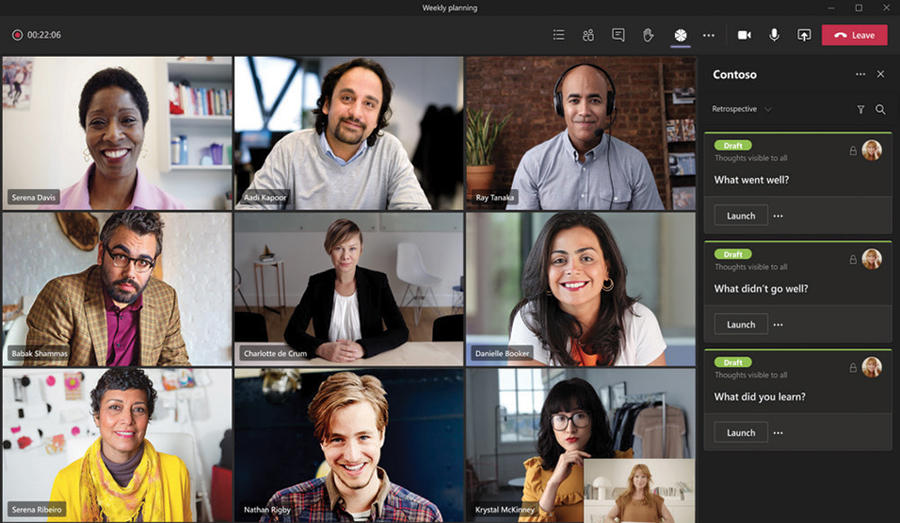- column
- TECHNOLOGY Q&A
Zoom vs. Teams vs. Google Meet: Which is right for you?
Please note: This item is from our archives and was published in 2021. It is provided for historical reference. The content may be out of date and links may no longer function.
Related
As Finance Duties Shift, CAOs Take On Strategic Role
Detecting anomalies with Benford’s Law in Excel
How multiple people can share screens simultaneously
TOPICS
Q. Like many, our accounting firm has relied heavily on Zoom during the coronavirus pandemic, but I have partners pushing us to change to Microsoft Teams. A couple of clients prefer Google Meet. Can you compare and contrast the three applications?
A. Nearly a year since the COVID-19 pandemic turned our country upside down, we continue to hold everything from work meetings to birthday parties on virtual platforms.
Most of the time, you simply click the link given to you and never think twice. But for those of us who have to host meetings, which platform is best? Let’s take a look at each.
Zoom
Pros: Great for webinars, conferences, and large groups.
Cons: Licensing can be expensive ($150 to $300 per year per license), especially if you’re only using it for one-on-one calls.
Advanced features: Multiscreen support, large group end-to-end encryption.
The term “Zoom room” has become quite common over the last year. Everyone is on Zoom — from our bosses to our teachers. This is because Zoom offers the best security for large group meetings.
Supporting multiple pages of video squares, Zoom allows you to host a large group and even set up a webinar easily. All meetings have the option to require a password, and invites are easy to send to anyone, whether or not they have a Zoom account.
While there is a free version of Zoom for those just looking to host personal calls, it should be noted that these calls are limited to 40 minutes and cannot be recorded or saved.
Zoom may be a bit of overkill for those who are just having one-on-one conversations with easy access to the other software we’ll be looking at in this article. That being said, if you’re constantly hosting brainstorming sessions or large get-togethers, Zoom is your best choice.

Microsoft Teams
Pros: Integration with Microsoft 365 allows for seamless document sharing/collaboration; free to users with a Microsoft 365 subscription.
Cons: Can be a struggle with large groups; webinar hosting requires a separate license.
Advanced features: Built-in security of Microsoft 365; the ability to schedule directly from Outlook.
For those of us who are used to working with Microsoft 365 in our normal business environment, Teams is (probably) going to come out on top. The two standout features of Teams include 365 integration and ease of use.
Say you want some help on your presentation or spreadsheet. Hit the call button on your co-workers’ Teams chat, and you’re instantly connected. From there, you can share the doc or simply share your screen. You can pass control over to the other party or easily invite others to join your session.
No hoops to jump through or extra clicks to get to your files. No extra licensing fees on top of your already existing Microsoft 365 subscription. Teams is hard to beat if you’re a Microsoft 365 subscriber.
If your business isn’t already using Microsoft 365, the other two options may be more enticing to you. There’s no need to pay for licensing when there are other free alternatives out there. Also, for those looking to host webinars, you’ll need to fork over some extra dollars to upgrade your licensing.

Google Meet (formerly Hangouts)
Pros: The go-to for anyone relying on Google Workspace (formerly G Suite) products for their business.
Cons: The free version limits video to one hour; only one person can share a screen at a time.
For those of us without any other licenses, or even those who have licenses but own Android devices, Google Meet is amazing. Seamless integration with Google Workspace apps (much like Teams with 365 apps) allows for intuitive collaboration. Also, all of your calls and video chats are automatically synced across all of your signed-in devices.
At the alluring price of $0 for basic features, Meet is the standout option for anyone looking to save some cash and still enjoy the videoconferencing features of Zoom and Teams.
Meet would not be the first choice for those hosting webinars or collaborating with large groups. Only one user is allowed to share their screen at a time, and the groups are limited in size from 100 participants to 250 participants in the paid plans, which range from $6 to $18 per person monthly. Even the Enterprise plan has a 250-attendee limit.

About the author
Byron Patrick, CPA/CITP, CGMA, is vice president of growth and success at Botkeeper.
Submit a question
Do you have technology questions for this column? Or, after reading an answer, do you have a better solution? Send them to jofatech@aicpa.org. We regret being unable to individually answer all submitted questions.



















